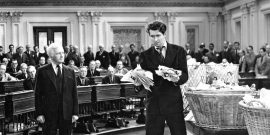Underpinning current arguments against the filibuster is the implicit desire to do away with politics inside the Senate altogether.
The New Retirement Calculus of Justices
The new politics of Supreme Court confirmations substantially affects the retirement calculus for justices. The elimination of the filibuster for Supreme Court nominations together with the much stronger possibility that a Senate controlled by one party will not confirm a Court nomination by the President of the other will change the date of many justices’ retirements.
Three objectives inform the retirement decisions of Supreme Court justices. First, justices would like to preserve their legacy and thus would prefer to be replaced by a justice like themselves. Second, most justices want to hand back the seat to a President of the party that appointed them. This is secondary to the first objective and when their judicial views diverge substantially from the party that appointed them, as it did in the cases of Justices Blackmun, Stevens and Souter, they will resign during the Presidency of the other party. Third, they want to resign at a time when it will not cause institutional damage to the Court or inconvenience to their colleagues.
The death of the filibuster and the possibility of a blockade generally makes it much easier to meet these objectives if the President and the Senate are controlled by the same party. First, the blockade can leave the Court short staffed, inconveniencing their colleagues. More importantly, the standoff between the President and Senate places the Court in a partisan cross-fire, harming its legitimacy.
In contrast, the absence of a filibuster gives a free hand to the party that appointed the justice if he resigns during a period of unified control of the Senate and Presidency by that party. But resigning during a period when his preferred party does not control the Senate may hand the seat to the other party. The effects on preserving a legacy may be more equivocal for a centrist justice. That justice might be advantaged by filibuster or divided control, because in the past it might have led to compromise. Today the centrist justice will have to consider which party’s unified control is likely to lead to the appointment of the justice closer to the ideal point of his jurisprudence.
And perhaps most interestingly this new world will lead justices to retire earlier than they would have before, because in the modern period unified control happens only two thirds of the time and thus only one third of the time on average for the party during whose Presidency the justice would like to retire. Thus, when unified control does occur, those justices who are thinking of retirement will seize it.
As a matter of concrete prediction, this new calculus makes it likely that Anthony Kennedy will retire before 2019, because he still identifies as a Republican and will probably think that his most important legacy not liked by many Republicans— his decision for same-sex marriage—is unlikely to be overruled. It even suggests that there is greater likelihood of Clarence Thomas’ retirement in the next two years. And besides taking account of the new political realities, both Justices Kennedy and Thomas also may reflect that decisions of Antonin Scalia not to resign early during George W. Bush’s Presidency and of Ruth Bader Ginsburg not to resign early in Obama’s presidency turned out to be very risky.


